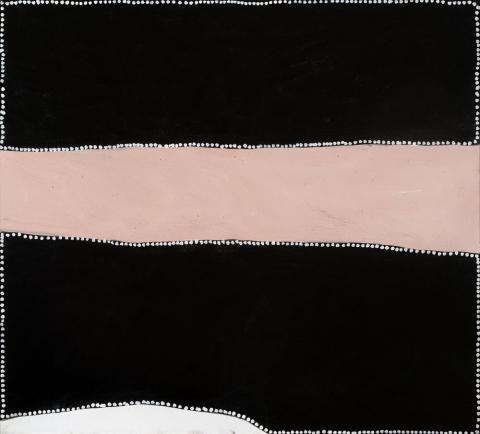GIRLINGMANJI (TWENTY MILE), 2001
PADDY NYUNKUNY BEDFORD
ochres and pigments with synthetic binder on linen
122.0 x 135.0 cm
bears inscription verso: title and Jirrawun Aboriginal Arts cat. PB 3.2001–107
Jirrawun Aboriginal Arts Corporation, Kununurra, acquired in 2003
Private collection, New South Wales
Storer, R., Paddy Bedford, Museum of Contemporary Art, Sydney, 2006, p. 150 (illus.)
Girlingmanji (Twenty Mile) is a bore site located south-west of Bedford Downs Homestead and adjacent to the Springvale-Landsdown road. It is characterised by black soil plains that run all the way to the base of the Durack Ranges at the edge of the East Kimberley plateau. Spring Creek runs through Girlingmanji and it is not far to the old Bedford road. This is a place intimately familiar to Paddy Bedford, as it is close to where he was born and educated in traditional lore. Bedford's grandfather was killed in a big fight in this country, and it is land he would have criss-crossed regularly when, in his adult years, he was employed working cattle on Bedford Downs station.
Painting his first works in 1997, aged 75, Paddy Bedford soon became recognised as an innovator and important artist through his unique depictions of East Kimberley history, and he is credited with evolving the artistic tradition forged earlier by Rover Thomas and Paddy Tjaminji. Crafting his own representations of country, Bedford’s formal language is characterised by a symbiotic relationship between bold forms and an elegance and balance in composition. His painting evokes rocky escarpments, rivers and other amorphous features of the Kimberley landscape, whilst at the same time containing a learned and poetical knowledge of the land and its creation stories.
It is important to note that multiple narratives intertwine in Bedford’s paintings. Family stories, historical events and a deep connection to his country are often masked by the simple, bold starkness of his technique. As curator Russell Storer observes, ‘his paintings articulate a complex dialectic between modern materials and traditional pictorial conventions, contemporary experience and ancient belief systems.’1
Girlingmanji (Twenty Mile), 2001 is catalogued as painting PB 3.2001.107 in the artist's chronological index of works, and was produced in the middle years of the artist's painting career. It exemplifies Bedford's move away from the familiar style of the earlier east Kimberley painters. With his elimination of the ochre palette and introduction of starkly contrasting black and white, the interplay between positive and negative space is highlighted and the form becomes dominant.
‘Paddy Bedford is one of Australia's most esteemed artists. His powerful and evocative paintings draw on rich traditions while his consistent innovations result in a diverse and dynamic body of work. Characterised by their bold forms, sinuous lines and complex spatial play, Bedford's paintings reveal a sheer love of painting, inspired by the dramatic and distinctive landscapes of his country in the East Kimberley region of Western Australia, and the stories of his people.’2
1. Storer, R., Paddy Bedford, Museum of Contemporary Art, Sydney, 2006, p. 11
2. Macgregor, E.A., 'Foreword', in Storer, R., Paddy Bedford, Museum of Contemporary Art, Sydney, 2006, p. 7
CRISPIN GUTTERIDGE
